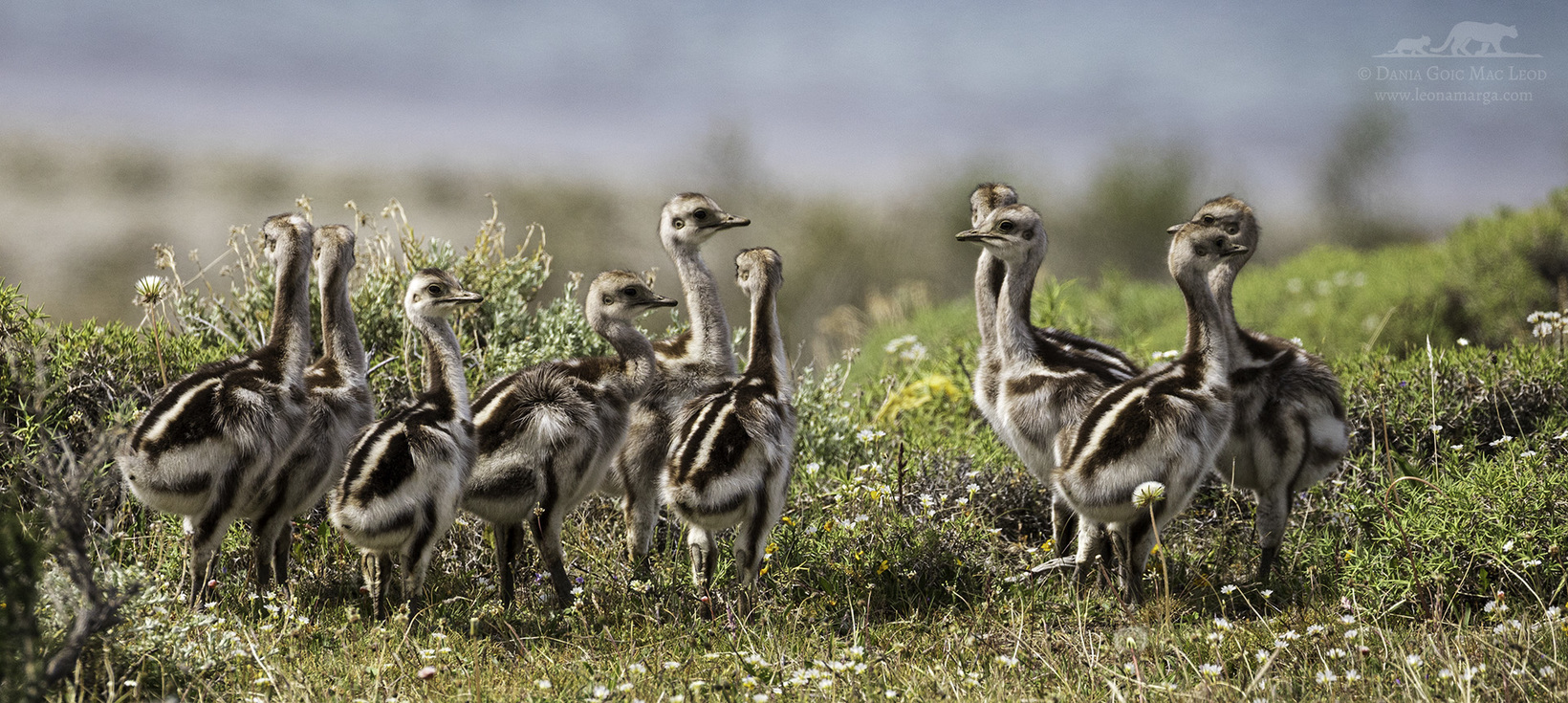Avifauna is associated with various environments such as the iconic Patagonian climate. One of the most striking birds of the Patagonian steppe is the unmistakable Lesser Rhea (Ñandú). In the summer season, we can see the male raising his chicks, called "charitas" in the surroundings of the great Lake Sarmiento.
In the meadows habitats, the feed can be found for the striking Black-faced Ibis (Bandurria), as well as breeding areas for the cryptic South American (Magellanic) Snipe (Becasina común), Magellanic Oystercatcher (Pilpilénaustral), Plumbeous Rail (Pidén), Correndera Pipit (Bailarín chico), Buff-winged Cinclodes (Churreteacanelado) and Sedge Wren (Chercán de las vegas), among other birds associated with the scrub of the sector mainly of Barberry (Calafate) bushes.
The attractive Torrent Duck (Pato cortacorrientes) breeds on the Paine river; while the Yellow-billed Teal (Pato jergónchico), Dark-bellied Cinclodes (Churrete común) and Blue-and-white Swallow (Golondrina de dorso negro) on the river rock edges. In the various interior lagoons, we can find Chilean Flamingo (Flamenco chileno), Black-necked Swan (Cisne de cuello negro), Coscoroba Swan (Cisnecoscoroba), Silvery Grebe (Blanquillo), the rare Hooded Grebe (Pimpollo tobiano), Red-gartered Coot (Tagua común), White-winged Coot (Tagua chica), Crested Duck (Pato juarjual), Spectacled Duck (Pato anteojillo), Chiloe Wigeon (Pato real), Yellow-billed Pintail (Pato jergóngrande), Brown-hooded Gull (Gaviota cáhuil), among the most common. On the shores of large brackish lagoons,Two-banded Plover (Chorlo de doble collar), Rufous-chested Dotterel (Chorlo chileno) and Baird`s Sandpiper(Playero de Baird), among the most common shorebirds in Patagonia can be watched. While on the shores of the vast Lake Sarmiento dives such as White-tufted Grebe(Pimpollo), Great Grebe (Huala) and occasionally some South American Tern (Gaviotín sudamericano) cannot be missed.
The aridest environments of the Patagonian steppe are suitable for various species of birds including migratory residents who visit us in the summer season. Many of them are in greater abundance in the mountain sector of Sierra Baguales, a natural corridor and migratory passage northeast of the province of Última Esperanza.
Some species of Tyrannidae associated with the steppe habitat are the colourful Chocolate-vented Tyrant(Cazamoscas chocolate) and Spectacled Tyrant (Run-run) both scarce in the area; the Fire-eyed Diucon (Diucón) and Austral Negrito (Colegial) which are quite common; in addition to flocks of Cinnamon-bellied Ground-Tyrant(Dormilona rufa), Dark-faced Ground-Tyrant (Dormilonatontita), Ochre-naped Ground-Tyrant (Dormilona fraile), which are local migratory residents gathered in numerous flocks during migration at the end of spring and late southern summer. The scarce Spot-billed Ground-Tyrant (Dormilona chica), has been registered by nesting in the high sector of the rocky conglomerates. Continuing with the high sector of the steppe (pampa), it is observed the scarce Tawny-throated Dotterel (Chorlo de campo), Rufous-banded Miner (Minero cordillerano), Plumbeous Sierra-Finch (Pájaro plomo), Yellow-bridled Finch (Yalcordillerano) and Least Seedsnipe (Perdicita común), with a very characteristic vocalization of the male during the spring.
In transition sectors of fragmented Antarctic Beech (Ñirre) forests and scrub areas, it is possible to contemplate and listen to owls such as Austral Pygmy-Owl (Chuncho), Short-eared Owl (Nuco), Magellanic Horned Owl (Tucúquere), Austral Parakeet (Cachaña), Chilean Flicker(Pitío), Rufous-tailed Plantcutter (Rara), the abundant Rufous-collared Sparrow (Chincol), Tufted Tit-Tyrant (Cachudito), the migrator White-crested Elaenia (Fío-Fío), Plain-mantled Tit-Spinetail (Tijeral), Sharp-billed Canastero (Canastero de cola larga), Austral Canastero (Canastero del Sur), Scale-throated Earthcreeper(Bandurrilla), Patagonian Mockingbird (Tenca patagónica) with its unique singing, Mourning Sierra-Finch (Yalcomún), Grey-hooded Sierra-Finch (Cometocino de Gay), Common Miner (Minero común), in addition to the elusive Band-winged Nightjar (Gallina ciega) around AmargaLagoon. In these particular scrub environments, valleys covered by the native "black bush" (Mata negra - Mulguraeatridens) and big rockeries, it is possible to find the three Shrike-Tyrant of the region: Black-billed Shrike-Tyrant(Mero gaucho), Great Shrike-Tyrant (Mero grande) and the rare Gray-bellied Shrike-Tyrant (Mero de Tarapacá).
As for birds of prey, the majestic Andean Condor (Cóndor) is common in the sector, quite associated with the abundance of food available mainly by the pumas of the area. It is easy to see groups of 15 – 30 individuals feeding hierarchically in a killing, along with other raptors and mammals waiting their turn.
Other birds of prey worth noting are Black-chested Buzzard-Eagle (Águila) that nests in conglomerates surrounding Goic Lagoon, the common ChimangoCaracara (Tiuque), Southern Caracara (Caranchos or Traros), the scarce and endemic White-throated Caracara(Carancho cordillerano del Sur). In recent years, a couple of White-throated Caracara has been in the area, this species is also closely related to the feeding of the puma, being one of the first species to detect the newly dead animal and position itself patiently at a predilect point. Other common diurnal birds of prey in the area are Cinereous Harrier (Vari), gliding at low altitude in search for prey; American Kestrel(Cernícalo); Aplomado Falcon (Halcón perdiguero) and Peregrine Falcon (Halcón peregrino) among the feared hunters of small birds.
In the surroundings of the houses of the estancia, it is frequent to sight flocks of Upland Goose (Caiquenes), Southern Lapwing (Queltehues) in the summer season, in addition to Eared Dove (Tórtolas) and Chilean Swallow (Golondrina chilena).
However, during the winter season, annual residents are scarce: Long-tailed Meadowlark (Loica) and Austral Blackbird (Tordo), as well as few specimens of Common Diuca-Finch (Diuca), among other species that descend in height looking for food. During the southern autumn, Cattle Egret (Garza boyera), Variable Hawk (Aguiluchos) and Chilean Hawk juvenile (Peuquito), in addition to Patagonian Tyrant (Viudita) in willows, and other migratory species from the humid western sector of Torres del Paine.
Preserving the environments, we will be protecting these beautiful winged beings of Patagonia.
